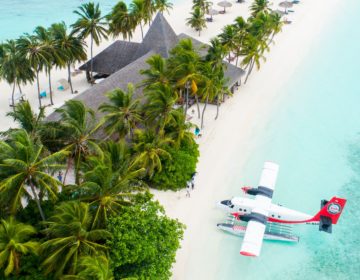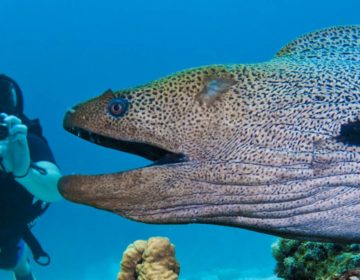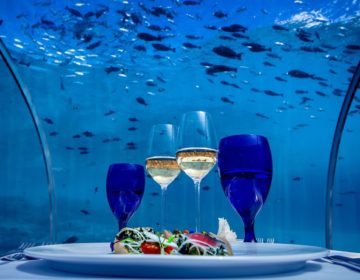Felidhe Atoll is located on the eastern range of the Maldives archipelago and is separated from South Malé Atoll by the 14 kilometers wide Fulidhoo Kandu. Felidhe Atoll is 42 kilometers long and 55 kilometers wide and shaped like a boot with the toe being Fotteyo Muli, which is reef protruding from the northern tip of Fotteyo Falhu. Fotteyo Falhu is one long unbroken reef extending from Hurahu Kandu in the east to Rakeedhoo Dhekunu Kandu in the south. It is the longest reef in the Maldives, being 55km long. The island of Fotteyo-bodufushi lies within the falhu and is the most eastern island in the archipelago. Felidhe Atoll has five inhabited islands – Fulidhoo, Thinadhoo, Felidhoo, Keyodhoo, and Rakeedhoo. There are ten uninhabited islands of which two, Dhiggiri and Alimathaa, are resorts and there are several small islands with bushes. Vattaru Atoll is a small round shaped atoll nine kilometers wide that lies 4.5 kilometers to the south of Felidhe Atoll. It has only one small uninhabited island, Vattarurah, and one kandu, Vattaru Kandu, on the southern side of the atoll. This channel is now a Protected Marine Area and a popular diving location. Safari boats often include this location on the Felidhe diving itinerary as well as a picnic at the island. A further 4.5 kilometers south is Mulaku Atoll.
 Felidhe Atoll Islands (Vaavu)
Felidhe Atoll Islands (Vaavu)
Fulidhoo
Fulidhoo is a picturesque inhabited island with neat coral houses lining the streets and thatched roofed fishing huts spread among the palm trees along the shores. The island has an excellent harbor and is a popular stopover for safari boats. The island has always been used by fishermen traveling between Malé and the southern atolls. The Islanders are famous for their bandiyaa, or ‘pot dance,’ performed by the womenfolk. Boduberus are also favorite pastimes with the menfolk, and the regular flow of visitors gives the Islanders an excuse to celebrate. The island is easily identified by a tall light on the eastern side of the island to mark the beginning of the atoll. There is a story related to the island of Fulidhoo which says that when the people were in the mosque attending Friday prayers, the Redhin (who were a group of mythical people who worshipped both idols and fire), came and set the mosque on fire. All the people, except for one, were burnt to death. The tomb of the survivor is still to be seen. (In Islands Of The Maldives, by Hassan Maniku).
 Fulidhoo Island
Fulidhoo Island
Dhiggiri
Dhiggiri means a long coral patch and opened as a tourist resort in 1982. It is a small round island set slightly back in the atoll with a good snorkeling reef.
Alimathaa
Alimathaa opened as a resort in 1975 and was among the first resorts to open. The resort offers good snorkeling and diving along the house reef on the south side of the island. There used to be islands on the nearby reefs of Kudadhiggaru Falhu and Kolhudhiffushi Falhu, but these washed away. Ali means light.
 Alimathaa Island
Alimathaa Island
Aarah
Aarah is the fourth island in the atoll and is uninhabited. It is a new island with a few bushes. The island has an extensive, shallow fringing reef preventing easy access.
Hulhidhoo
Hulhidhoo is a small heavily wooded uninhabited island with narrow fringing reefs on the north and south sides, which are excellent for snorkeling. Hulhi means a coconut, or fruit, with nothing to eat inside. If visiting the island, be prepared for a little man appearing from the trees with a sign reading: “Deserted island – $2.00.”
 Hulhidhoo Island
Hulhidhoo Island
Thinadhoo
Thinadhoo is the sixth island in the atoll and is sometimes called Mas Thinadhoo, or fish island. In the southern atolls, Thina is the breast of a woman.
Felidhoo
Felidhoo is an inhabited island and the capital of the atoll. The island has a high radio mast. The Islanders are mostly fishermen and are well known for their boduberus.
Keyodhoo
Keyodhoo is an inhabited island with a good anchorage in the lagoon. Safari boats often stop here to top-up water supplies, and after dinner, crew members often desert ship to enjoy the local hospitality.
 Keyodhoo Island
Keyodhoo Island
Foththeyo-bodufushi
Foththeyo-bodufushi lies on the eastern fringe of the atoll. It is uninhabited and used to be two separate islands, Foththeyo and Bodufushi, before becoming naturally joined. It is a large island with a radio mast on it.
Hingaaguraa
Hingaaguraa means moving island and is a small uninhabited island on Fotteyo Falhu.
Bodumohoraa
Bodumohoraa is a further seven kilometers west on the same falhu. It is a sizeable uninhabited island with plenty of trees, a lovely beach on the south side and a shallow water lagoon.
 Bodumohoraa Island
Bodumohoraa Island
Thunduhuraa
Thunduhuraa is a small sandbank island with no trees, only a few bushes.
Ruhhurihuraa
Ruhhurihuraa is one-and-a-half kilometers to the north of Thunduhuraa. It is a small uninhabited island with coconut trees. Ruh means coconut tree and huri means there are.
Rakeedhoo
Rakeedhoo is an inhabited island that lies at the southern tip of the atoll. Safari dhonis sometimes anchor overnight on the north side of the island to make an early morning dive in Rakeedhoo Kandu.
Anbaraa
Anbaraa is a medium-sized deserted island with about 30 coconut trees and is 15 minutes by Dhoni from Rakeedhoo. It has good anchorage and is a pleasant island to visit for a barbecue on the beach. Anbaraa comes from the word ambergris, the valuable secretion from sperm whales sometimes found washed up on beaches.
Kuda Anbaraa
Kuda Anbaraa is a small uninhabited island with some palm trees six kilometers to the north of Anbaraa.
On the western corner of the atoll is a large reef called Fussaru Falhu. Fussaru means invisible reef, so named because boats approaching the atoll from the west have no clearly visible islands to tell them where the atoll starts. On the next reef north – Maahiththan Faru – is another small nameless island with no trees and it has a radio mast on it.
Fussaru Huraa
Fussaru Huraa is a small uninhabited island.

Kudaboli
Kudaboli is an uninhabited island on the Masaraa Falhu. Kudaboli means small shell island.
Ambergris
The sea gives life to many myths and legends, but few stories can match those that are born from the valuable nuggets of ambergris that can be found floating in the sea or washed on the beaches of islands.
Ambergris is a waxy substance produced in the intestines of sperm whales. Sperm whales eat deep-sea squid, and it is believed that the undigested beaks of the squid cause irritation to the internal organs of the whale. In response, the whale produces a secretion which coats these beaks, and it is this highly prized secretion that is passed out at either end, which is of such value. When heated it gives out a particularly agreeable perfume and is used for medicinal purposes and perfumes.
The Chinese of the 10th and 11th century called ambergris ‘dragon spittle’ and they collected most of it from the Liu Mountains (the Maldives). Sheng-Tseng wrote: “These are a great many coiled up dragons among the rocks of these islets. In spring they vomit spittle, which flocks of birds collect, and swarms of fish suck up, the yellow kind is like fish glue, the black like the dung of bats, the white resembles Pai-Yao-Chien.”
The Arabs thought differently. Suleiman wrote in the ninth century: “The sea throws up on the shore of these islands big lumps of amber: some of these pieces have the form of a plant, or nearly so. Amber grows at the bottom of the sea like the plants; when the sea is much disturbed, it throws up the amber in pieces like pumpkins or truffles.”
The Portuguese soldier Barbosa, in the east between 1501 and 1517 was intrigued by it and wrote: “I have ofttimes asked these Moors what thing this ambergris was, and whence it sprang. Among themselves they hold it to be the dung of the birds, and they say that in this archipelago among the uninhabited islands there are certain great fowls which alight on the cliffs and rocks of the sea, and there drop this ambergris, where it is tanned and softened by the wind, the sun, and the rain, and pieces both great and small are torn by the storms and tempests and fall into the sea until they are found and washed up on the strands or swallowed by whales.”
An anonymous Portuguese writer writing before 1505, found out the true source of ambergris. He wrote: “On the shores of the Dyve islands, dead whales are to be found. They are often thrown ashore by the waves, and the inhabitants cut them and make oil of their meat. Some of these whales have pieces of ambra like pinecones, big and small ones, 20 to 40 or even 100 and sometimes up to 200 pieces joined in a sticky bunch. This ambra they must deliver to the sultan, if they do not they are sentenced to death. Nobody tries to steal it as it is under penalty of death.”
The value of ambergris is such that when one becomes suddenly rich, it is commonly said that he has found ambergris, as though it were a treasure. It was only the rich or the royal, however, who kept it. In 1599, the English pilot John Davies reported being greeted near Malé by a “gentleman and his wife,” and it mentions that in the woman’s casket were jewels and ambergris. The man, who was dressed “in the Turkish manner” and had rings with rich stones, is believed to have been Sultan Ibrahim III.
The freedom of the people has been bought with ambergris. In 1754, a piece weighing 152.8 kgs was presented to the French in return for their services in defeating a fleet of Malabar vessels that had been plundering the islands.
Ambergris found today is worth around US$20/gm and if exported is taxed 100% by the government. In March of 1995, a piece weighing 187 kgs, the second largest piece found in this century, was found by fishermen off the island of Kelaa, in North Thiladhunmathee Atoll. The largest piece of 214 kgs was found in the early 1980s. Needless to say, finding a piece of ambergris is like unearthing a nugget of gold. However, the fortunate discoverer must grab hold of it first try – once touched it sinks to the bottom and takes days to surface.

(Source: Dive Maldives: A guide to the Maldives Archipelago. Tim Godfrey. Atoll Editions)



